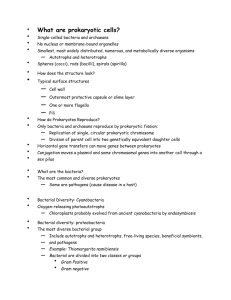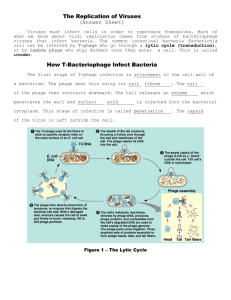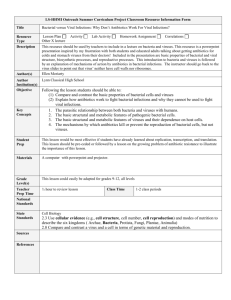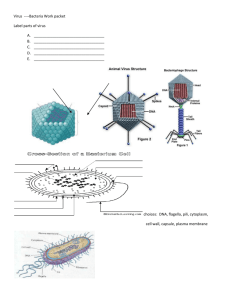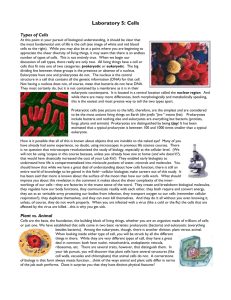Chapter-19
advertisement
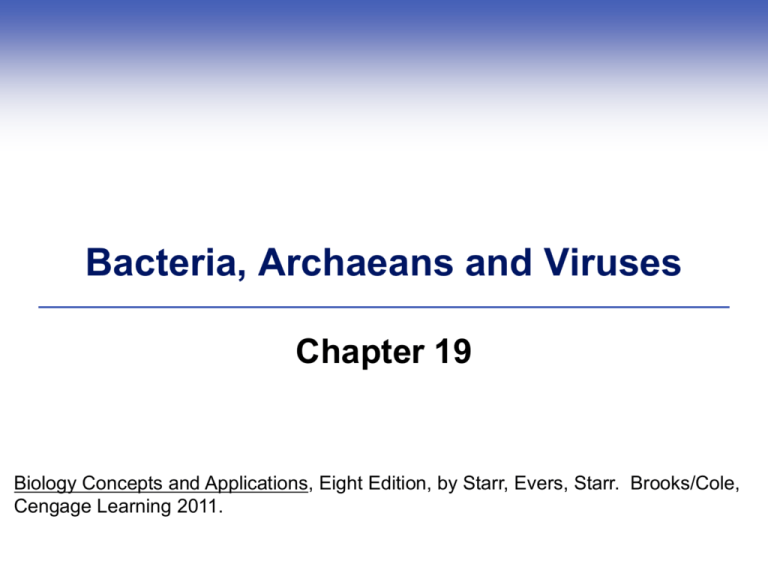
Bacteria, Archaeans and Viruses Chapter 19 Biology Concepts and Applications, Eight Edition, by Starr, Evers, Starr. Brooks/Cole, Cengage Learning 2011. 19.1 Evolution of a Disease Billions of years ago the Earth’s sea was home to bacteria and archaeans Viruses are non-living • No chromosomes, ribosomes, or metabolic machinery • Can evolve because they have genes that mutate HIV Human immunodeficiency virus • Isolated 1980s, however first infected humans in the early 1900s • Two strains: HIV-1 and HIV-2 • HIV-1 evolved from simian immunodeficiency virus that infects wild chimpanzees • Hypothesis • First infected human ate meat from a SIV-infected chimp • The spread • 1966: Africa Haiti • 1969: Haiti USA HIV 20 million people have died from AIDS and about 3 million are infected with HIV Disease mechanism • Virus infects and replicated inside white blood cells (WBC) • WBC die decreased immune response 19.2 Viral Structure and Function Viruses are noncellular infectious particles that cannot reproduce on their own Viruses infect a host cell; their genes and enzymes take over the host’s mechanisms of replication and protein synthesis Each type of virus has structural adaptations that allow it to infect and replicate in hosts • Bacteriophages infect bacteria Virus Structure A virus particle consists of a core of DNA or RNA and a protein coat In some viruses, the coat is enveloped in some of an infected cell’s plasma membrane • Outer envelope forms as each new virus particle is released by budding or lysis In bacteriophages and other complex viruses, the coat has a sheath and other structures Viral Structures Five Steps of Viral Multiplication Cycles Viral Multiplication Pathways Multiplication pathways vary greatly Two are common among bacteriophages • Lytic pathway • Lysogenic pathway Lytic Pathway New virus particles are released by lysis • Multiplication is rapid • The host is killed Lysogenic Pathway Virus enters a latent state that extends the cycle • Host cell is not killed outright Viral nucleic acids integrate into host chromosome • All host cell’s descendants inherit genetic material • May be reactivated many generations later, causing cell to enter lytic pathway • Like tiny little bombs Bacteriophage: Lytic and Lysogenic Pathways a Virus particle binds, injects genetic material. DNA in protein coat tail fiber a Viral DNA is inserted into host chromosome by viral enzyme action sheath b Chromosome and integrated viral DNA are replicated. e Lysis of host cell lets new virus particles escape. Lytic Pathway d Accessory parts are attached to viral coat. c Viral proteins selfassembleinto a coat around viral DNA. Lysogenic Pathway b Host replicates viral genetic material, builds viral proteins. d Viral enzyme excises viral DNA from chromosome. c Cell divides; recombinant DNA in each daughter cell. Fig. 19.13, p.313 Enveloped Virus: Herpes Multiplication HIV Replication Cycle 19.3 Viral Effects of Human Health Pathogen disease-causing agent • Adenovirus upper respiratory infection and the common cold • Viral gastroenteritis stomach flu • Human papillomavirus genital warts, cervical cancer • Chicken pox (children) shingles in adults • Influenza, mumps, and measles Emerging Disease (ex. AIDS) • A disease that was previously unknown or has recently begun spreading to a new region • Mutation can result in a new disease (RNA virus’) West Nile Virus Enveloped RNA virus that replicates in birds Mosquitoes carry the virus from host to host • Mosquito is the vector • Vector animal that carries a pathogen form one host to the next West Nile Virus can cause West Nile Fever • 1% virus enters the nervous system fatal 1999 introduced to Western Hemisphere West Nile Virus is an endemic disease in the US • Endemic disease that persists at a low level in a region or population SARS – Sudden Acute Respiratory Syndrome Appeared in 2002 – China • Initial virus infected Chinese horseshoe bats • Became epidemic disease outbreak limited to one region • Air travel resulted in a pandemic outbreak of disease that affects many separate regions and poses a serious threat to human health • In 9 mons SARS sickened 8,000 people in 37 countries, killing 774. Influenza H5N1 and H1N1 Flu in the winter months Mutations result in different flu viruses each year H5N1 Bird Flu • 417 cases (2003-2009), 257 fatal (60%) • Person to person transmission rare H1N1 swine flu • Easily transmitted by a cough or sneeze • Mexico 2009 severe respiratory symptoms • Low death rates, antiviral drugs releases, vaccine created 19.5 Viroids and Prions Viroids • Small circles of noncoding RNA without a protein coat • Many cause disease in plants Prions Mad Cow Disease • Proteins that occur naturally in the vertebrate nervous system, but can cause fatal disease when they misfold Key Concepts: NONCELLULAR INFECTIOUS PARTICLES Viruses are noncellular particles that cannot replicate themselves without taking over the metabolic machinery of a host cell A protein coat encloses their DNA or RNA and a few enzymes Some viruses become enveloped in membrane when they bud from host cells Key Concepts: NONCELLULAR INFECTIOUS PARTICLES (cont.) Viroids and prions are even simpler than viruses Viroids are short sequences of infectious RNA Prions are infectious misfolded versions of normal proteins Characteristics of Prokaryotic Cells Single-celled bacteria and archaeans No nucleus or membrane-bound organelles Smallest, most widely distributed, numerous, and metabolically diverse organisms • Autotrophs and heterotrophs 19.5 Bacterial Structure and Function Spheres (cocci), rods (bacilli), spirals (spirilla) Bacterial Cell Structures Typical surface structures • • • • Cell wall Outermost protective capsule or slime layer One or more flagella Pili • Hairlike extension form the cell wall of some bacteria Bacterial Cell Structures Inside the cell • Bacterial chromosomes • Circle of double-stranded DNA that resides in the bacterial cytoplasm • Nucleoid • Cytoplasmic region where prokaryotic chromosomes lie A Bacterial Cell Flagella and Pili Bacterial Nutrition Modes •Photoautotroph •photosynthetic, use light energy to build organic compounds form carbon dioxide and water •Chemoautotroph •get energy by removing electrons from sulfides •Photoheterotroph •use light energy to get carbon by breaking down organic compounds •Chemoheterotroph •get carbon and energy by breakings down organic compounds from other organisms Bacterial Nutrition Modes 19.6 Bacterial Reproduction and Gene Exchange Only bacteria and archaeans reproduce by binary fission: • Replication of single, circular prokaryotic chromosome • Division of one parent cell into two genetically equivalent daughter cells • Asexual Reproduction Prokaryotic Fission a The bacterial chromosome is attached to the plasma membrane prior to DNA replication. b Replication starts and proceeds in two directions from a certain site in the bacterial chromosome. c The DNA copy becomes attached at a membrane site near the attachment site of the parent DNA molecule. d Then the two DNA molecules are moved apart by membrane growth between two attachment sites. e Lipids, proteins, and carbohydrates are built for new membrane and new wall material. Both get inserted across the cell’s midsection. f The ongoing, orderly disposition of membrane and wall material at the midsection cuts the cell in two. Fig. 19.4, p.307 Gene Exchange Between Prokaryotes Horizontal gene transfers can transfer genetic material between prokaryotes (bacteria and archaeans) Conjugation moves a plasmid and some chromosomal genes into another cell through a sex pilus • Plasmid a small ring of nonchromosomal DNA replicated independently of the chromosome Review: Prokaryotic Cell Characteristics Key Concepts: DISTINCTLY PROKARYOTIC FEATURES We divide all prokaryotic cells into domains Bacteria and Archaea Structurally simple, single-celled organisms • Don’t have a nucleus or the diverse cytoplasmic organelles found in most eukaryotic cells Collectively, they show great metabolic diversity Key Concepts: PROKARYOTIC FEATURES (cont.) Only bacteria and archaeans reproduce by binary fission Exchanges of chromosomal DNA and plasmid DNA often occur within and among species 19.7 Bacterial Diversity The most common and diverse prokaryotes • Some are pathogens (cause disease in a host) Bacterial Diversity: Heat-loving Modern heat-loving bacteria may resemble early cells that emerged in thermal pools Near the base of the bacterial family tree One species discovered in a volcanic spring in Yellowstone National Park Bacterial Diversity: Cyanobacteria Oxygen-releasing photoautotrophs • Release oxygen by noncylic pathways, as plants do • Chloroplasts probably evolved from ancient cyanobacteria by endosymbiosis Bacterial Diversity: Cyanobacteria Oxygen-releasing photoautotrophs • Heterocysts carry out nitrogen fixation Incorporation of nitrogen gas into ammonia • Plant and algae can take up ammonia produced and released by cyanobacteria to retrieve the nitrogen they need Bacterial Diversity: Proteobacteria The most diverse bacterial group • Include autotrophs and heterotrophs, free-living species, beneficial symbionts, and pathogens • Escherichia coli • Chemoheterotroph that live in the mammalian gut • Normal flora • Normally harmless or beneficial microorganisms that typically live in or on a body • Heliobactor pylori stomach ulcers • Vibrio cholerae cholera Bacterial Diversity: Proteobacteria The most diverse bacterial group • Example: Thiomargarita namibiensis • Chemoautotroph stores nitrogen and sulfur in huge vacuole Bacterial Diversity: Gram-Positive Bacteria Most are chemoheterotrophs • Ex. Lactobacillus lactate fermentor (yogurt, cheese) • Some are human pathogens Have thick walls • Gram staining • The process used to prepare bacterial cells for microscopy, and to distinguish groups based on cell wall structure Gram Stain Pink – cyanobacteria and proeobacteria Purple DNA spore coat capsule around cell wall Fig. 19.7, p.309 Bacterial Diversity: Gram-Positive Bacteria Have thick walls • Endospores resist heat, boiling, irradiation, acids and disinfectants • Endospore is a resistant resting stage of some soil bacteria Bacterial Diversity: Gram-Positive Bacteria Gram positive soil bacteria that form endospores • Clostridium botulinum • Anaerobe botulism paralyzing food poisoning • Clostridium tetani • Tetanus lock muscles in contraction • Bacillus anthracis • Anthrax toxin interferes with breathing Other Gram-Positive Bacteria • Mycobacterium tuberculosis tuberculosis • Strephtococcus Strept throat • Staphlococcus boil or skin abscess Bacterial Diversity: Chlamydias Chlamydias • All are intracellular parasites of eukaryotic cells • Obtain ATP from host cells • Some sexually transmitted diseases (C. trachomatis) Bacterial Diversity: Spirochetes Spring-shaped resemble a stretched-out spring • Live on their own or in hosts • Some are pathogens (Syphilis, Lyme disease) 19.8 The Archaeans Archaeans are prokaryotic, but like eukaryotic cells in certain features Comparisons of structure, function, and genetic sequences put archaeans in a separate domain, between eukaryotes and bacteria Archaeans are more diverse and widely distributed than previously thought Three Archaean Groups On the basis of their physiology, archaeans fall into three groups • Methanogens • Extreme halophiles • Extreme thermophiles Three Archaean Groups Methanogens • Organisms that produce methane (CH4) • Adapted to anaerobic conditions • Exposure to oxygen inhibit their growth or kills them • Live near deep sea vents, in soil, in ocean sediments. • Live in human and animal guts and gas is released by flatulence Three Archaean Groups Extreme halophiles • Highly salty environments • Live in Dead Sea, The Great Salt Lake Extreme thermophiles • High temperature • Live in Hot springs and near deep sea vents (temp 110oC/230oF) Archaean Physiology Halophiles (salt lovers), extreme thermophiles, and methanogens (methane makers) Archaeans in Extreme Environments Key Concepts: THE PROKARYOTIC LINEAGES Bacteria are the most studied prokaryotic species They are the most abundant and widely distributed organisms Archaeans, discovered more recently, are less well known Many are adapted to extreme environments Evolution and Disease Hosts coevolve with pathogens • Hosts evolve defenses • Pathogens evolve to not kill a host before they can infect other host individuals Mycobacterium tuberculosis SARS virus Ebola virus p.315 Antibiotic Resistance Use of antibiotics favors antibiotic-resistant bacteria Genes that convey drug resistance can arise by mutation, may spread among members of the same or different species by conjugation Deadly Pathogens Diseases can be fatal • If an individual becomes host to multiple pathogens • If an individual has no coevolved defenses • If a pathogen mutates into a different form that can breach current defenses Two deadly emerging pathogens • Ebola and the H5N1 strain of bird flu Deadliest Infectious Diseases Key Concepts: THE BAD BUNCH An immense variety of pathogens, or diseasecausing agents, infect human hosts Pathogens and their hosts have been coevolving by way of natural selection Animation: Bacteriophage multiplication cycles Animation: Body plans of viruses Animation: Examples of Bacteria Animation: Gram staining Animation: Lysogenic pathway Animation: Lytic pathway Animation: Prokaryotic body plan Animation: Prokaryotic conjugation Animation: Binary fission
